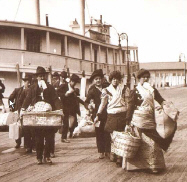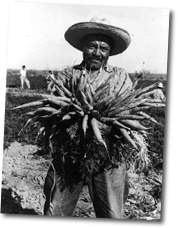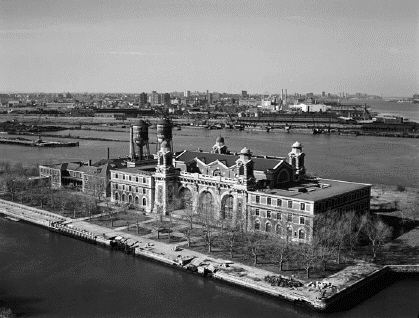Multiple Choice
Identify the
choice that best completes the statement or answers the question.
|
|
|
Through the "Golden
Door"
Millions of immigrants entered the United States in the late 19th and early
20th centuries because they were lured by the promise of a better life. Some of these immigrants
sought to escape difficult conditions-such as poverty, famine, land shortages, or religious or
political persecution-in their native countries. Others, known as "birds of passage,"
intended to immigrate temporarily in order to make money and then return to their
homelands.
IMMIGRANTS FROM EUROPE
Between 1870 and 1920, approximately 20
million Europeans arrived in the United States. Before 1890, most immigrants came from countries
in western and northern Europe, including Great Britain, Ireland, and Germany. Beginning in the
1890s, however, increasing numbers came from southern and eastern Europe, especially Italy,
Austria-Hungary, and Russia. In 1905 alone, about a million people arrived from these countries
through the "golden door" to the land of opportunity.
Many of these new immigrants
left their homelands to escape religious persecution. During the
19th century Russia there were attacks by mobs against the Jews. These were often approved or
condoned by those in authority.Whole villages of Jews-business people,
intellectuals, workers, and farmers -were driven out of Russia by pogroms. These were organized
anti-Semitic campaigns that led to the massacre of Jews during the early 1880s and early
1900s.Pogrom is Russian for "devastation".
Other Europeans left because of rising population. Between 1800 and 1900,
the population in Europe more than doubled, reaching 432 million. This population explosion
resulted in a scarcity of land for farming. Farmers as well as laborers often found themselves
competing for too few industrial jobs. Some emigrated to the United States, where jobs were
supposedly plentiful.
Finally, there was a spirit of reform and revolt in Europe, especially
after the political disturbances in France, Germany, Italy, and elsewhere in the late 1840s.
Many young European men and women who were influenced by American
ideals of freedom sought to start independent lives in the United States |

The Statue of Liberty

Arriving
Immigrants | | |
|
|
|
1.
|
Between 1870 and 1920 about how
many Europeans immigrated to the United States.
a. | 100
thousand | c. | 20
million | b. | 10 million | d. | very few |
|
|
|
2.
|
Before 1890 most European
immigrants to the U.S. came from _____
a. | Italy | c. | Eastern Europe | b. | the Balkans | d. | Northern Europe |
|
|
|
3.
|
Most of the people who
immigrated to the United States were ____
a. | trying to escape suffering in other
parts of the world | c. | were
subversives | b. | not very grateful to be Americans | d. | only wanted to get rich |
|
|
|
4.
|
With open arms, America
welcomed suffering people and did not require that they be rich to immigrate to the United
States
|
|
|
5.
|
America refused to accept
European Jews because of their religion.
|
|
|
6.
|
After reading the passages
above, which statement below is most true about the United States.
a. | Most of the people who come to
America were lazy and only came for the welfare they can get | c. | Most people who came to America came because they were too
lazy to stay in their own countries and work for reform | b. | America was and is a symbol of hope and freedom for people
all over the world. People come to America for a better life. | d. | Most people who came to the United States found themselves in worse conditions
than they were in their homelands. |
|
|
|
IMMIGRANTS FROM CHINA AND
JAPAN
While waves of Europeans arrived on the shores of the East Coast, Chinese
immigrants came to the West Coast in smaller numbers. Between 1851 and 1883, about 200,000
Chinese arrived. Many came to seek their fortunes after the discovery of gold in 1848 sparked the
California gold rush. The Chinese helped build the nation's first transcontinental
railroad as well as other railroads in the West. When the railroads were completed, they turned
to farming, mining, and domestic service. Chinese immigration was sharply limited by a congressional
act in 1882.
In 1884, the Japanese government allowed Hawaiian planters to recruit Japanese
workers, and a Japanese emigration boom began. When the United States annexed Hawaii in 1898,
Japanese emigration to the West Coast increased. As word of comparatively high American
wages spread in Japan, the number of Japanese who entered the United States each year reached
about 10,000. By 1920, more than 200,000 Japanese lived on the West
Coast.
| |
|
|
|
7.
|
Most of the Western railroads
were built by
a. | Chinese
immigrants | c. | native
Americans | b. | Japanese immigrants | d. | Europeans from Eastern Europe |
|
|
|
8.
|
Japanese immigrants needed the
permission of _______ to emigrate to Hawaii
a. | the California
government | c. | the Queen of
Hawaii | b. | a suite filed with the Supreme Court of the United States for Japanese civil
rights | d. | the Japanese
government |
|
|
|
9.
|
The Congress tried to slow down
Chinese immigration by passing a law in 1882
a. | true | c. | Congress does not have control of
immigration | b. | false | d. | Only the President can pass a
law |
|
|
|
 | IMMIGRANTS FROM THE WEST INDIES AND
MEXICO
Between 1880 and 1920, about 260,000 immigrants arrived in the eastern and
southeastern United States from the West Indies. They came from Jamaica, Cuba, Puerto Rico, and
other islands. Many West Indians left their homelands because jobs were scarce.
The Mexican
population in the United States also increased. Unlike the Europeans, Asians, and West Indians,
however, some Mexicans became U.S. residents without even leaving home. As a result of the
annexation of Texas in 1845 and the treaty with Mexico in 1848, the United States acquired vast
territories from Mexico. Many of the residents of these territories chose to become American
citizens.
Other Mexicans immigrated to the United States to find work or to flee political
turmoil. As a result of the 1902 National Reclamation Act (also known as the New lands Act), which
encouraged the irrigation of arid land, new farm land was created in many Western states, including
Texas, Arizona, and California. This farmland drew Mexican farm workers northward to seek
jobs. After 1910, political and social upheavals in Mexico prompted even more immigration.
Nearly a million people-7 percent of the population of Mexico at the time-came to the United States
over the next 20 years.
| | |
|
|
|
10.
|
Which statement is true about
Mexican immigration to the United States
a. | Most Mexicans would rather not
immigrate to the U.S. in the early 1900’s | c. | There was very little immigration to the United States from Mexico prior to
the 1950’s | b. | Most Mexicans immigrated to the U.S. for the money. There was no persecution
of people by the Mexican government | d. | There was a great deal of immigration to the U.S. by Mexicans for many reasons
in the early 1900’s |
|
|
|
11.
|
When Texas became a state there
were many Mexicans living in the Texas territory. Most of them decided to return to Mexico rather
than become American citizens.
a. | true | c. | there is no way to tell | b. | false |
|
|
|
12.
|
When Texas became a state, all
of the Mexicans living in the state were driven back into Mexico because Americans are
racist.
|
|
|
 | A DIFFICULT JOURNEY
By the 1870s, almost
all immigrants traveled by steamship. The trip across the Atlantic Ocean from Europe took
approximately one week, while the Pacific crossing from Asia took nearly three weeks. For many
immigrants, the long sea journey was stormy, uncomfortable, and frightening.
Many
immigrants traveled in steerage or in the cargo holds below a ship's waterline. Rarely
allowed on deck, immigrants spent most of the trip crowded together in the gloom, unable to exercise
or catch a breath of fresh air. They often had to sleep in louse-infested bunks and share toilet
facilities with many other passengers. Under these conditions, diseases spread quickly, and some
immigrants died before they reached their destination. For those who survived the first glimpse
of America could be breathtaking.
| | |
|
|
|
13.
|
Which immigrants had the
longest and most difficult journey to the United States.
a. | Italians | c. | Asians | b. | Europeans | d. | Mexicans |
|
|
|
ELLIS ISLAND

The processing of immigrants on Ellis Island was an ordeal that
might take five hours or more. First, they had to pass a physical examination by a doctor. Any
who were found to have a serious health problem or a contagious disease, such as tuberculosis, were
promptly sent home or quarantined. Those who passed the medical exam then reported to a government
inspector. The inspector checked documents and questioned immigrants to determine whether they met
the legal requirements for entering the United States. The requirements included passing a
literacy test in their native language, proving that they were able to work, and showing that they
had at least $25.
From 1892 to 1943, Ellis Island was the chief immigration station in the
United States. More than 16 million immigrants passed through its noisy, bustling facilities.
During the peak immigration years from 1905 to 1907, as many as 11,000 immigrants a day hurried down
the long staircase leading to the ferry that would take them to New York City and their new
lives.
| |
|
|
|
14.
|
At Ellis Island immigrants were
examined and questioned to see if they met the requirements for admittance to the United States. What
percentage failed and were sent back to their home countries?
|
|
|
15.
|
Which of the following
requirements did the immigrants not have to prove to the U.S. agents at Ellis Island.
a. | that they were in good
health | c. | that they could speak
English | b. | that they were able to work | d. | that they could read and write in their native
language |
|
|
|
16.
|
Ellis Island was
a. | a
hospital | c. | an army
base | b. | a prison | d. | an immigration station |
|
|
|
 | ANGEL ISLAND
While European immigrants
arriving on the East Coast passed through Ellis Island, Asians-primarily Chinese arriving on the
West Coast gained admission at Angel Island in San Francisco Bay. Between 1910 and 1940, about
50,000 Chinese immigrants entered the United States through Angel Island. In contrast to the
procedure at Ellis Island, processing at Angel Island included questioning and a long detention while
government officials decided whether to admit or reject an immigrant.
The Angel Island
facility consisted of ramshackle buildings in which Chinese immigrants were confined like prisoners.
To protest these terrible conditions, some immigrants rioted in 1919.
| | |
|
|
|
17.
|
Conditions for immigrants were
worse at
a. | Ellis
Island | c. | the Mexican
border | b. | Angel Island | d. | immigrants were treated the same at all
facilities |
|
|
|
18.
|
The main immigration facility
on the east coast was _____ while the main facility on the west coast was _____
.
a. | Angel Island - Ellis
Island | c. | San Francisco Armory - New York
Armory | b. | Ellis Island - Angel Island |
|
|
|
EXPERIENCING CULTURE
SHOCK
Immigrants also had to deal with culture shock-confusion and anxiety
resulting from immersion in a culture whose ways of thinking and acting they didn't understand.
Some con men and thieves took advantage of the newcomers' bewilderment and stole their money and
possessions. Most immigrants faced the ongoing nightmare of finding a place to live, getting a job,
and dealing with the problems of daily life while trying to understand an alien language and
customs.
Many immigrants reacted to culture shock by seeking out people who shared their
cultural values, practiced their religion, and spoke their native language. Ethnic communities
sprang up in areas that had large concentrations of immigrants.
| |
|
|
|
19.
|
Ethnic neighborhoods such as
China Town in San Francisco, Little Italy and Irish Hells Kitchen in New York were created by
immigrants who sough out people of their own culture for support.
a. | True | c. | There is no way to tell | b. | False | d. | Immigrants were forced by the government into
ghettos |
|